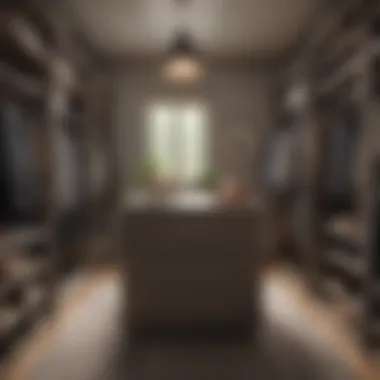Declutter Your Closet: A Complete Guide to Organization


Intro
Decluttering your closet is more than just a practical chore; it holds psychological importance and influences your overall well-being. A disorganized closet can lead to stress, frustration, and wasted time as you struggle to find what you need. On the contrary, an organized closet promotes a sense of control and calm in your life. This guide will provide you with effective strategies and methodologies designed to help you streamline your space while developing sustainable habits that prevent unnecessary accumulation.
Understanding your clutter is the first step in this journey. It requires intentional decision-making about what you choose to keep and what can be let go. Therefore, the focus will be on practical steps aimed at enhancing organization, optimizing space, and addressing the psychological impacts of clutter. By using systematic approaches and considering your design preferences, this guide aims to equip you with the necessary tools to maintain a clutter-free environment.
As you navigate the process of decluttering, remember that this is not just about getting rid of items. It is an opportunity to reflect on your lifestyle and what truly adds value to your life. This guide aims to provide insights into how to achieve a balance between practicality and aesthetics in your closet space.
Understanding the Need for Decluttering
Decluttering is more than just a routine cleaning task; it is a fundamental practice that can significantly influence both our physical and mental well-being. Clutter tends to accumulate gradually, often managed until it becomes overwhelming. Understanding why decluttering is essential can lead to a more organized life and offer insights into how to effectively approach this task.
The Psychological Effects of Clutter
Clutter can have profound psychological effects on individuals. A busy environment often leads to distractions, making it difficult to focus. Studies reveal that individuals living in cluttered spaces report increased stress and anxiety levels. This clutter acts as a barrier to productivity, as it diverts attention and creates a sense of chaos. Furthermore, visual clutter can activate the brain's fight-or-flight response, triggering feelings of unease or discomfort. By decluttering, one can create a more serene atmosphere, which is conducive to clearer thinking and reduced stress levels. An organized closet symbolizes not just physical order, but also a mental shift towards clarity and calm.
Benefits of an Organized Closet
An organized closet provides several tangible benefits that extend beyond mere aesthetics. Firstly, it simplifies the daily routine. When everything is in its designated place, locating items becomes straightforward, ultimately saving time during busy mornings. An organized closet can also optimize space, making your belongings more accessible.
Additionally, an organized closet allows for better visibility of what you own. This visibility can deter unnecessary purchases, leading to more sustainable habits. Furthermore, the sense of accomplishment derived from organizing can boost self-esteem and foster good mental health.
In summary, understanding the necessity of decluttering is crucial not only for enhancing the physical space but also for promoting mental well-being. As one begins to prioritize this practice, they may find a significant shift in both emotional and practical aspects of their lives.
Preparing for the Process
Before embarking on the journey of decluttering your closet, it is essential to prepare adequately. Taking the time to plan your approach will enhance the effectiveness of the decluttering process. This preparation phase is where you set the foundation for a successful strategy. You will ensure that you have clear objectives and the right tools to execute your plan.
One of the key benefits of preparing is that it reduces the overwhelm often associated with decluttering. A well-prepared mindset can lead to more productive outcomes. It helps prevent rash decisions that can result in regret later. Instead of diving into the chaos, you can approach the task with clarity and purpose. By laying out your plan, you can focus on specific areas and tasks, making the entire process more manageable.
Setting Realistic Goals
Setting realistic goals is a critical step in the decluttering journey. Ambitious aims like "I will completely organize my closet in a single day" may not be practical. Instead, break down the process into smaller, achievable targets. For instance, you might set a goal to sort through only a part of your closet at a time.
These goals can include:
- Time Allocation: Decide how much time you can dedicate each day to decluttering. This could be 30 minutes to an hour.
- Specific Areas: Focus on one type of clothing or section of your closet at a time. For example, start with shoes first, then move on to shirts.
- Emotional Readiness: Be honest about your psychological readiness. If certain items hold sentimental value, acknowledge that and set goals that allow for gentle decision-making.
By setting clear and realistic goals, you pave the way for a more organized and efficient process.
Gathering Necessary Supplies
Once you have established your goals, it’s time to gather the necessary supplies. Ensuring you have the right tools can make a considerable difference in your efficiency.
The following items are often helpful when decluttering:
- Trash Bags: For items that are beyond saving, having a readily available trash bag is crucial.
- Boxes or Bins: Use these for sorting items. Labeling boxes can help you categorize items into bins such as "Keep," "Donate," and "Discard."
- Cleaning Supplies: As you clear out your closet, you will likely want to clean the space itself. Dust cloths and mild cleaning solutions are useful.
Collecting your materials in advance ensures that you can proceed without interruption. Being well-equipped enhances your overall decluttering experience.
Strategically Emptying Your Closet
Emptying your closet is more than just a physical task; it is a foundational step in the process of decluttering. This phase allows for a fresh perspective on what you have, enabling informed decision-making. It is about creating an environment where you can assess each item clearly, without the distraction of existing clutter. The importance of this step cannot be overstated, as it significantly lays the groundwork for successful organization.
Assessing Your Closet Configuration


Before you start removing items from your closet, spend some time evaluating its layout. Each closet is unique, influenced by its size, shape, and the type of storage used. Identifying how you use space can guide you on what should be kept and what can be removed. Ask yourself the following questions:
- What items do I access most frequently?
- Are there areas in my closet that are consistently cluttered?
- Is my current organization system effective?
Identifying these factors will assist you in determining which sections are utilized well and which may need a different strategy. Assessing your closet configuration now improves accessibility and satisfaction in the long run.
Taking Everything Out
The next step involves physically removing all items from your closet. This is a crucial part of the decluttering process. It creates a blank slate, allowing you to see every item. Here are some key points to consider when doing this task:
- Take everything out of the closet. This means clothing, accessories, and any storage bins.
- Create designated areas for items you will sort through. Consider using your bed or a large space in your room.
- Avoid the temptation to skip items. Touch each item just once; this will prevent you from second-guessing your decisions later.
Taking everything out can be a daunting task, but it is an effective way to stimulate the decision-making process. Once your closet is empty, you can start the process of sorting your belongings, empowered by the visibility of your entire collection.
Sorting Your Belongings
Sorting your belongings is a crucial step in the decluttering process. It allows you to assess what you truly need and want while identifying items that may have outlived their usefulness. This section is fundamental as it lays the groundwork for establishing an organized closet. The process of sorting helps to create clarity and intention in how you use your space.
When you sort your belongings, you engage in a decision-making process that influences your overall environment. Without sorting, the risk is high that clutter will re-accumulate, leading to the same issues you aimed to overcome. A thorough sorting strategy can reveal hidden treasures as well as clear out redundancy, providing a more streamlined, functional closet.
Categorizing Items
Categorizing items can significantly enhance the sorting process. Begin by grouping similar types of clothing and accessories together. For instance, consider separating pants from shirts and outerwear, or grouping pieces by seasonal wear. This systematic approach allows for a clearer overview and makes it easier to evaluate each category.
You may want to use the following categories as a starting point for your closet sorting:
- Daily wear: clothes you use most often.
- Special occasions: outfits reserved for events.
- Seasonal gear: items that are specifically for summer or winter.
By defining these categories, you create a structured method for evaluating your belongings. This activity not only organizes the space but also helps to clarify which pieces genuinely contribute to your lifestyle.
The Decision-Making Process
Keeping
Keeping items in your closet plays a vital role in reducing clutter. It signifies what you value and involves conscious choices based on your current lifestyle and needs. The key characteristic of keeping is intentionality. It requires that you reflect on whether each piece adds value to your daily routine.
This approach helps maintain only those items that align with your present circumstances or style. A unique feature of keeping is that it encourages a proactive mindset towards your belongings. However, an overemphasis on sentimentality can lead to retaining unnecessary items, which can clutter your space once more.
Discarding
Discarding items offers a helpful avenue for dealing with clutter. When you decide to let go of belongings, it can lead to a sense of relief and newfound space. The main characteristic of discarding is its decisive nature. It allows for a clean break from items that no longer serve a purpose.
This choice is beneficial because it promotes a minimalist approach, reducing distractions and visual noise in your closet. The unique feature of discarding is the opportunity it provides to refresh your collection. However, it may involve emotional struggles, particularly with items that invoke strong memories.
Donating
Donating items is another meaningful process in decluttering. This choice allows you to contribute positively to others' lives while simultaneously relieving your own space. The essential characteristic of donating is its altruistic aspect. You are not simply getting rid of things; you are sharing and potentially helping someone in need.
The unique feature of donating is the satisfaction derived from knowing your items will find a new home. It can be a sustainable alternative to simply discarding items. Nonetheless, one must ensure that the items donated are in good condition, so they effectively serve their new purpose.
By implementing a structured sorting method, you are empowered not only to declutter but also to cultivate an intentional living space that mirrors your values and needs.
Establishing an Organization System
Creating an effective organization system is crucial when it comes to decluttering your closet. Not only does it help maintain order, but it also maximizes the use of available space. An organized closet allows for easier access to items, reduces stress, and promotes efficiency in daily activities. With a well-thought-out approach, you can choose methods that align with your lifestyle and preferences. This ensures that the effort put into decluttering does not go to waste and that the benefits last over time.


Methods of Organization
By Type of Clothing
Organizing by type of clothing refers to grouping similar items together, such as tops, bottoms, dresses, or outerwear. This method simplifies the process of finding what you need when you need it. One key characteristic of organizing by type is that it allows you to visualize your wardrobe effectively. This can highlight any gaps or excess within your collection. A beneficial aspect of this method is that it reduces decision fatigue, as you can quickly choose from one category without searching through unrelated items.
However, there can be a disadvantage. It may not always suit everyone's style or wardrobe size, especially if you have a diverse collection that mixes various types. In small spaces, this method might leave little room for flexibility in your choices.
By Frequency of Use
Organizing by frequency of use involves placing items that you wear often at eye level or in easily accessible locations. Seasonal clothing or rarely used items can go higher or further back in the closet. The main benefit of this approach is its alignment with practical use, ensuring that you can grab what you need without digging through less frequently worn pieces.
One unique feature of this method is that it encourages regular evaluation of your wardrobe. If you find you haven't worn something in a while, it may be time to consider parting ways with it. Nevertheless, this method can require adjustments, especially when seasons change, resulting in a shift in what you wear regularly.
By Color
Organizing by color is visually appealing and can be pleasurable to the eye. Clothes grouped by colors create a sense of order and make it easy to locate specific pieces. This method can be particularly popular among individuals who enjoy aesthetics and want their closet to be a reflection of their personal style.
The unique feature here is the visual impact. Flawlessly arranged colors can make your closet look artful. However, a potential disadvantage is that it does not address practicality. Finding a specific item may take longer if you are unsure of its color, especially in a large wardrobe.
Utilizing Storage Solutions
Having a proper storage solution is part of an effective organization system. Consider using bins, baskets, or boxes to further categorize and store items efficiently. Incorporating hangers, hooks, and shelving can maximize vertical space and reduce clutter.
When you choose your storage solutions, think about:
- The size of your closet
- The types of items being stored
- Ease of access to frequently used items
Taking time to find the right method and storage solutions can ensure that your closet remains functional and clutter-free for the long term.
Maintaining a Clutter-Free Closet
Maintaining a clutter-free closet is not merely about aesthetics; it reflects a broader philosophy of order and functionality in life. A cluttered closet can lead to daily frustrations, impacting how smoothly your morning routine runs. Without a system in place, finding appropriate attire can feel like a daunting task, leading to stress and wasted time. When one adopts strategies to keep their closet organized, the benefits extend far beyond mere convenience.
Keeping the closet organized provides psychological relief. Studies show that clutter can increase feelings of anxiety and overwhelm, while a neat environment can promote focus and calm. This stability encourages clarity in decision-making, fostering a more intentional approach to not only clothing choices but also overall lifestyle choices.
A clutter-free closet encourages mindful consumption. When you can easily see what you have, it becomes less likely that you will buy unnecessary items. This conscious awareness leads to better financial decisions and a reduced environmental impact, aligning with sustainable living practices. Thus, maintaining an organized space is directly correlated with personal well-being, financial prudence, and ethical considerations in consumption.
Routine Decluttering Practices
Regular maintenance of your closet is crucial to prevent a buildup of unnecessary items. Establishing routine decluttering practices can help keep your wardrobe manageable and streamlined.
- Seasonal Reviews: Review your closet at the start of each season. This is an excellent opportunity to assess what you wore and what didn’t make it out of the closet. Consider donating any items that have not seen daylight in recent months.
- Monthly Touch-Ups: Set reminders each month to spend a short amount of time (perhaps 15 minutes) organizing. A quick run-through can often reveal items that have slipped out of place or space that has become overcrowded.
- The One In, One Out Rule: For every new item you bring in, consider removing one old item. This rule helps to avoid accumulating too many possessions and promotes a mindset of mindful consumption.
Implementing these practices creates a habit of decluttering, reinforcing the idea that organization is a continuous process rather than a one-time task.
Establishing a Clothing Rotation System
A clothing rotation system is instrumental for maintaining a well-organized closet. This strategy not only helps you utilize all of your clothes but also empowers you to make intelligent choices about what to wear.
- Categorization: Divide your clothing into categories based on seasons, occasions, or types. For instance, separate casual wear from business attire or winter clothes from summer dresses.
- First In, First Out: When you add new items to your closet, place them behind older items. This arrangement encourages you to wear older items that might otherwise be neglected.
- Recommended Usage: If certain items are worn more frequently, place them in easy-to-reach areas while less frequently used items can be stored further back. Creating a system based on usage fosters better accessibility.
Adopting a clothing rotation system not only streamlines your selection but also maximizes the functional use of your closet space.
"A closet filled with clothes that you love, that fit you well, and that suit your lifestyle reflects an organized life." - Anonymous


Adopting Sustainable Practices
In the context of decluttering your closet, adopting sustainable practices is crucial not just for the environment, but also for fostering a mindful relationship with your belongings. When you consider how your choices impact the planet and society, you make more thoughtful decisions about what to keep and what to let go. Sustainable decluttering involves finding eco-friendly ways to dispose of unwanted items as well as seeking to minimize future waste. It, therefore, serves a dual purpose: enhancing your personal space while being considerate of broader environmental issues.
Eco-Friendly Disposal Options
When it comes to disposing of items, consider methods that do not harm the environment. Here are some options:
- Donation: Giving clothes or accessories to local shelters, charities, or thrift stores can benefit those in need and keep items out of landfills. Organizations like Goodwill and Salvation Army often welcome donations.
- Buyback Programs: Retailers like Patagonia have programs that allow customers to sell back used items. This promotes recycling and extends the lifecycle of products.
- Recycling: For items beyond repair or donation, investigate recycling programs in your area. Some cities have textile recycling programs that can handle old fabric.
- Upcycling: Repurposing items into something new can reduce waste and add creativity to your space. Think of ways to reuse old clothes or storage items instead of discarding them.
"Conscious consumption creates a ripple effect that can lead to significant positive changes in society and the environment."
These eco-friendly disposal options align with a sustainable lifestyle and reduce the environmental impact associated with excessive waste in landfills.
Reducing Future Clutter
Preventing future clutter is just as important as dealing with current items. To maintain a sustainable and organized closet, consider the following practices:
- Mindful Shopping: Evaluate your purchases deliberately. Ask yourself if an item is necessary and if it fits your wardrobe needs before buying.
- Quality Over Quantity: Invest in higher quality items that last longer instead of trendy, low-quality fashion. This reduces turnover and limits waste.
- Wardrobe Rotation: Implement a system where you regularly assess your closet and rotate items seasonally, perhaps by putting away off-season clothing. This reminds you of what you have and can minimize spontaneous purchases.
- One-In, One-Out Rule: For every new item you bring home, consider letting go of an existing item. This maintains a stable number of items in your closet and encourages careful selection when shopping.
By incorporating these sustainable practices, you enhance your closet organization and contribute positively to the environment. Mindfulness in consuming and disposing can lead to a more sustainable lifestyle overall.
Evaluating Progress
Evaluating progress is a critical step in the decluttering process. It allows you to reflect on what you have achieved and the effectiveness of your strategies. This evaluation is essential not only for assessing the physical aspects of your closet but also for understanding the psychological journey that accompanies decluttering. The sense of accomplishment can reinforce your commitment to maintaining an organized space.
When you take the time to evaluate progress, you become aware of patterns in your decluttering efforts. This awareness can lead to adjustments in your methods, ensuring that they align with your goals of organization and sustainability. Additionally, celebrating small victories helps to maintain motivation.
Reflecting on the decluttering journey can also help you identify any recurring issues. For instance, if you find yourself accumulating items again, you may need to revisit your strategies on how to reduce future clutter.
Setting Milestones
Setting milestones can greatly enhance your decluttering experience. Milestones serve as tangible markers of success. They allow you to break down the process into smaller, manageable goals. Instead of feeling overwhelmed by the idea of decluttering an entire closet, you can focus on achieving one segment at a time.
Consider defining specific milestones such as:
- Clearing Out Seasonal Items: Aim to remove seasonal clothing every few months.
- Completing a Category: Choose a category, like shoes or accessories, to complete within a week.
- Donating a Specific Amount: Commit to donating at least ten items in one month.
These focused goals can make the process less daunting and more rewarding.
Reflecting on the Outcome
After your decluttering efforts and achieving your milestones, reflecting on the outcome is imperative. This reflection allows you to assess not only the physical results but also the emotional impacts of your actions. Did you feel lighter and freer after removing excess items? Were there any surprises in what you decided to keep or discard?
You might want to consider keeping a journal to note your thoughts and experiences. Documenting your feelings can increase your awareness of what worked well and what did not. It guides future decluttering sessions and helps you continually refine your approach.
In summary, evaluating your progress, setting milestones, and reflecting on outcomes are integral to successful decluttering. These processes ensure that the efforts you put in result in meaningful and lasting changes to your closet and, ultimately, to your lifestyle.
Final Considerations
Final considerations are crucial when it comes to maintaining a well-organized closet. After you have invested time and effort into decluttering and reorganizing, taking a moment to reflect on what you have learned can be immensely beneficial. First, personalizing your closet space is essential. It is not just about functionality but also about creating a space that resonates with you. This can enhance your daily routine and encourage consistent upkeep.
A personalized closet reflects your lifestyle and preferences, making the process of choosing outfits more enjoyable. Customizing your closet doesn’t need complex designs; simple touches like a specific arrangement of shoes or displaying your favorite accessories can make a significant difference.
Another vital aspect is creating a long-term vision. The decisions you make today can have lasting effects. Visualizing how you want your closet to evolve over time encourages a mindset focused on sustainability and intentionality. A clear vision helps in mitigating clutter from accumulating again.
In essence, your final considerations should serve as a guide for future actions. Deliberate and conscious choices can lead to better organization, ultimately resulting in a more fulfilling experience. You should always ask yourself: Will this item add value? How can I maintain this space?
"Ultimately, organization is a continuous journey, not a one-time destination."
Maintaining this mindset will support the longevity of the systems you put in place. With a proactive approach, your closet will remain an organized haven rather than a chaotic space.







